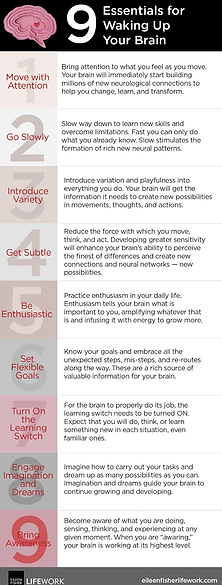Anat Baniel Method Neuromovement
General overview
Anat Baniel has a scientific and medical background, and is a doctor of psychology. She was trained by Dr. Feldenkrais in the 1970s, and developed her own practice in the United States in the 1980s: Neuromovement. Her method is based on the Feldenkrais Method (see Feldenkrais card), Anat Baniel having been one of her closest collaborators.
Anat Baniel founded her centre in California and her training as a practitioner, based on the Feldenkrais Method and enriched by her extensive personal experience with atypical children on the one hand, and on the other hand by her training in psychology and current knowledge in neuroscience (with a collaboration in particular with Pr. M Merzenich, UCSF).
The ABM method is particularly focused on children with neurodevelopmental disorders, with a large part of the training course dedicated to working with children.
Translated with www.DeepL.com/Translator (free version)
Main objectives of the method
Motricity: complete perception of one's body image, improvement of ease of movement (allowing access to the next acquisition)
Cognitive: creating meaning in life experience
Helping the brain to create differentiation "intelligence is the perception of differences" (sensory, visual-spatial differences...),
See also the Feldenkrais sheet (largely common goals).
Specificities of the method
The "9 essentials" are the 9 founding principles that summarize the specificities of the method:
Attention: Pay attention to what you feel during the movement to develop the capacity to learn.
Slow: Slowing down is the best way to learn and overcome your limitations. Only the automatic movement is possible in speed.
Variation: Introducing variation in everything we do brings a plurality of experiences to the brain and helps it to select what works.
Subtlety: Reduce the force and instead look for the smallest movements, which make it easier to understand the differences.
Enthusiasm: the brain is designed to record what is done with enthusiasm and what is perceived as good for it, to observe and rejoice in every little change.
Flexibility: Rather than focusing on the objective, be open to possibilities, seize opportunities, always start from current capabilities (not from what you would like to achieve).
Awakening: Turn on the "learn" button in everything you do, feel or perceive, including everyday situations, avoid automatisms that do not offer learning potential.
Imagination: Imagining a gesture, inventing solutions to a problem, children's imagination is precious and stimulates brain activity and learning.
Consciousness: The presence of the child in the movement, his consciousness, allows him to observe himself and to understand what he is doing and learning.
These 9 principles are used by the practitioner during the individual sessions but are also taught to the parents so that they can best accompany their children in everyday life (see the book "The Anat Baniel Method", ie "Kids beyond limit", by Anat Baniel).
"Movement Is the Language of the Brain." Anat Baniel
Through movement, the child increases his conscious attention and carries out non-verbal kinesthetic experiences: his brain is then able, after having experienced them, to select the most functional and effective movements, supports and postures. The child creates a more complete image of himself.
Lessons take place in intensive sessions, usually 6 to 10 sessions over a week.
Translated with www.DeepL.com/Translator (free version)


Who is this method for ?
The Anat Baniel method is for children with motor or cognitive disorders, including cerebral palsy, hemiplegia, hemiparesis, autism, sensory integration disorders, communication and language disorders, trisomy...
What parents say about it
"We started when Raphaël was three months old and we saw the progress very quickly, he learned to turn around, to turn his head as much on both sides. Today, he uses both sides of his body equally and he walked at 16 months."
"We come from far away, every school holiday because every time Tom makes a lot of progress in walking and language. Since he started two years ago, his behaviour has changed a lot, he has less aggression."
"Pierre has made enormous progress with this method, he started at the age of 4, speech therapy did not suit him, he did not speak. After one week of training, there was a clear evolution, the progress of the last two years was immense, he speaks 2 languages and his behaviour with others has changed".
Translated with www.DeepL.com/Translator (free version)
Scientific references
Lack of efficacy studies conducted
https://www.cadth.ca/fr/efficacite-clinique-des-methodes-anat-baniel-et-feldenkrais-chez-lenfant
To know more about the topic
Reference books: The Anat Baniel Method, Anat Baniel
Website: https://www.anatbanielmethod.com/
The Brain's Way of Healing, Norman Doidge: http://www.normandoidge.com/?page_id=1042
Videos of sessions with Anat
https://www.youtube.com/watch?v=LPP_77rl-Qc&feature=emb_logo
https://www.youtube.com/watch?v=cMwTDihs6Ps&feature=emb_logo
https://www.youtube.com/watch?v=k4R_5Y17Zfs&feature=emb_logo
Scientific references
Any remarks or comments ?
This work is based on a collaborative approach to sharing research and family experience.
If you have any comments, suggestions for modifications or corrections or clarifications to make, please let us know by email at contact@leneurogroupe.org




